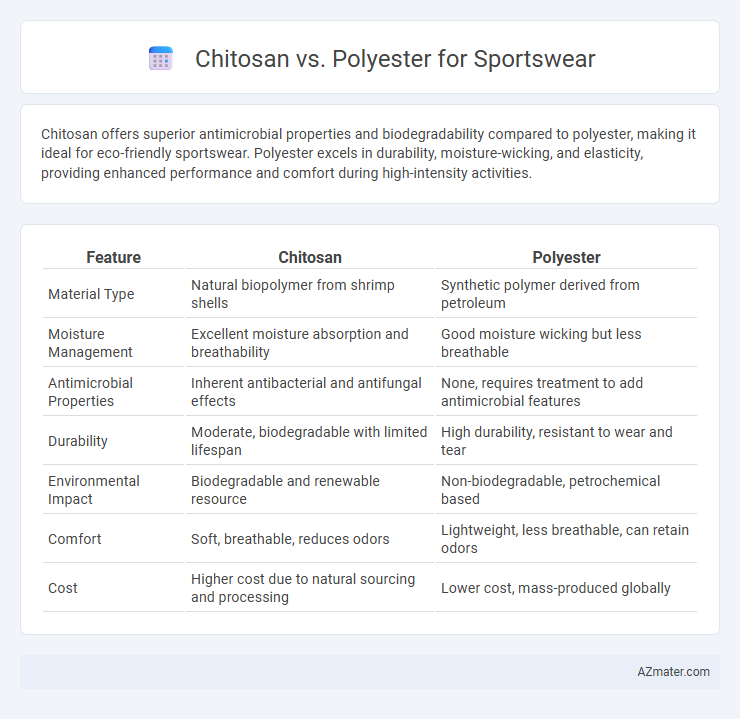Chitosan offers superior antimicrobial properties and biodegradability compared to polyester, making it ideal for eco-friendly sportswear. Polyester excels in durability, moisture-wicking, and elasticity, providing enhanced performance and comfort during high-intensity activities.
Table of Comparison
| Feature | Chitosan | Polyester |
|---|---|---|
| Material Type | Natural biopolymer from shrimp shells | Synthetic polymer derived from petroleum |
| Moisture Management | Excellent moisture absorption and breathability | Good moisture wicking but less breathable |
| Antimicrobial Properties | Inherent antibacterial and antifungal effects | None, requires treatment to add antimicrobial features |
| Durability | Moderate, biodegradable with limited lifespan | High durability, resistant to wear and tear |
| Environmental Impact | Biodegradable and renewable resource | Non-biodegradable, petrochemical based |
| Comfort | Soft, breathable, reduces odors | Lightweight, less breathable, can retain odors |
| Cost | Higher cost due to natural sourcing and processing | Lower cost, mass-produced globally |
Introduction to Chitosan and Polyester in Sportswear
Chitosan, a natural biopolymer derived from chitin in crustacean shells, offers antimicrobial properties and excellent moisture-wicking capabilities, making it ideal for sportswear focused on hygiene and comfort. Polyester, a synthetic polymer known for its durability, high tensile strength, and quick-drying features, is widely used in sportswear for enhanced performance and longevity. Both materials serve critical roles in sportswear innovation, balancing natural functionality and synthetic resilience.
Material Origins and Production Processes
Chitosan, derived from the exoskeletons of crustaceans, is a natural biopolymer known for its biodegradability and antimicrobial properties, making it an eco-friendly option for sportswear. Polyester, a synthetic polymer produced through the polymerization of petrochemical derivatives such as ethylene glycol and terephthalic acid, offers durability, moisture-wicking capabilities, and high elasticity. The production of chitosan involves deacetylation of chitin extracted from shellfish, while polyester manufacturing relies on energy-intensive chemical processes, resulting in differing environmental impacts and performance characteristics in sportswear applications.
Moisture-Wicking and Breathability Comparison
Chitosan fibers exhibit superior moisture-wicking properties compared to polyester due to their natural hydrophilicity and antimicrobial characteristics, which help manage sweat and reduce odor during intense physical activity. Polyester, while lightweight and durable, tends to trap moisture against the skin, often requiring chemical treatments to enhance breathability and moisture management. The inherent breathability of chitosan enhances air circulation and skin comfort, making it a more effective material for maintaining dryness and ventilation in sportswear applications.
Antibacterial and Odor-Resistant Properties
Chitosan exhibits superior antibacterial properties compared to polyester, as its natural biopolymer structure disrupts bacterial cell membranes and inhibits microbial growth. This leads to enhanced odor-resistant capabilities in chitosan-based sportswear, effectively reducing sweat-induced odors during intense physical activities. Polyester, while durable and moisture-wicking, lacks inherent antimicrobial properties and often requires chemical treatments to achieve similar odor control.
Comfort and Skin Sensitivity Considerations
Chitosan fibers excel in moisture-wicking and antimicrobial properties, enhancing comfort and reducing skin irritation in sportswear compared to traditional polyester. Polyester, while durable and quick-drying, can trap heat and cause discomfort for sensitive skin due to its synthetic nature. Athletes with sensitive skin benefit more from chitosan-infused fabrics that promote breathability and minimize allergic reactions during intense physical activity.
Durability and Longevity in Athletic Use
Chitosan fibers offer excellent durability and antimicrobial properties that enhance longevity in athletic use by resisting odor and bacterial growth, unlike polyester which is prone to retaining sweat and developing odors over time. Polyester provides high tensile strength and abrasion resistance, supporting extended wear during intense physical activities, but can degrade faster under UV exposure and repeated wash cycles compared to chitosan. The biocompatibility and natural resilience of chitosan combined with its environmental benefits make it a promising alternative to synthetic polyester for sustainable and long-lasting sportswear.
Environmental Impact: Biodegradability and Sustainability
Chitosan fibers exhibit superior biodegradability compared to polyester, breaking down naturally without releasing harmful microplastics into the environment. Derived from renewable sources like crustacean shells, chitosan supports sustainable production practices, whereas polyester relies on petroleum-based resources with significant carbon emissions. Choosing chitosan for sportswear reduces long-term ecological footprints through enhanced compostability and lower dependency on fossil fuels.
Cost Analysis: Affordability for Consumers
Chitosan sportswear typically carries a higher price point due to its natural antimicrobial properties and sustainable sourcing compared to polyester, which is mass-produced and widely available at lower costs. Polyester remains more affordable for consumers seeking budget-friendly athletic wear, benefiting from established manufacturing processes and abundant raw materials. Cost analysis reveals that while chitosan offers health and environmental benefits, polyester's affordability makes it the preferred choice for cost-conscious shoppers.
Performance Feedback from Athletes
Athletes report that chitosan-based sportswear offers superior moisture-wicking and natural antibacterial properties, reducing odor during intense workouts. Polyester garments excel in durability and quick-drying capabilities but may retain odors longer due to synthetic fibers. Feedback highlights that chitosan blends enhance comfort and hygiene, making them increasingly preferred for high-performance athletic wear.
Future Trends in Sportswear Fabrication
Chitosan-based fabrics are gaining momentum in sportswear fabrication due to their natural antibacterial properties and biodegradability, addressing sustainability demands and reducing odor during intense physical activities. Polyester remains dominant for its durability, moisture-wicking capabilities, and cost-effectiveness but faces challenges regarding environmental impact and microplastic pollution. Future trends emphasize blending chitosan with polyester to create hybrid textiles that combine performance benefits with eco-friendly attributes, aligning with the growing consumer demand for sustainable yet functional sportswear.

Infographic: Chitosan vs Polyester for Sportswear
 azmater.com
azmater.com